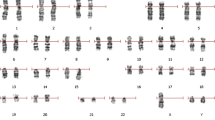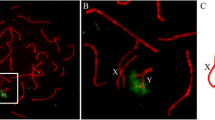Abstract
Human sperm chromosomes from a 46,XY/ 47,XXY male were obtained using the technique of in vitro penetration of zona-free hamster eggs. The analysis of 543 sperm complements shows a significantly increased incidence (0.9%) of hyperhaploid gonosomal 24,XY sets, with a lack of the expected corresponding gonosomal hypohaploidies, and a normal rate of autosomal non-disjunctions. These results support the suggestion that 47,XXY cells are able to go through meiosis and to form spermatozoa. Only 24,XY sperm chromosomal constitutions were observed suggesting a preferential pairing of homologous sex chromosomes in 47,XXY spermatocytes.
Similar content being viewed by others
References
Benet J, Martin RH (1988) Sperm chromosome complements in a 47,XYY man. Hum Genet 78: 313–315
Benet J, Navarro J, Genescà A, Egozcue J, Templado C (1991) Chromosome abnormalities in human spermatozoa after albumin or test-yolk capacitation. Hum Reprod 6: 369–375
Brandriff B, Gordon L, Asthworth L, Watchmaker G, Moore II D, Wyrobek AJ, Carrano AV (1985) Chromosomes of human sperm: variability among normal individuals. Hum Genet 70: 18–24
Dutrillaux B, Lelorier G, Salat J, Rotman J (1971) Incidence des anomalies chromosomiques dans la stérilité masculine. A propos d'une étude de 40 cas. Presse Méd 79: 1231–1234
Estop AM, Cieply K, Vankirk V, Munne S, Garver K (1991) Cytogenetic studies in human sperm. Hum Genet 87: 447–451
Estop AM, Levinson F, Cieply K, Vankirk V (1992) The segregation of a translocation t(1;4) in two male carriers heterozygous for the translocation. Hum Genet 89:425–429
Evans EP, Ford CE, Chaganti RSK, Blank CE, Hunter H (1970) XY spermatocytes in an XYY male. Lancet 1: 719–720
Goldman ASH, Martin RH, Johannisson R, Gould CP, Davison EV, Emslie JE, Burn J, Hulten M (1992) Meiotic and sperm chromosome analysis in a male carrier of an inverted insertion (3;10)(q13.2;p14p13). J Med Genet 29:460–464
Hogg H, McLaren A (1985) Absence of a sex vesicle in meiotic foetal germ cells is consistent with an XY sex chromosome constitution. J Embryol Exp Morphol 88:327–332
Hultén M, Pearson PL (1971) Fluorescent evidence for spermatocytes with two Y chromosomes in an XYY male. Ann Hum Genet 34:273–276
Kjessler B (1966) Karyotype, meiosis and spermatogenesis in a sample of men attending an infertility clinic. Monogr Hum Genet 2:1–92
Laurent C, Papathanassiou Z, Haour B, Cognat M (1973) Etude mitotique et méiotique de 70 cas de stérilité masculine. Andrologie 5: 193–200
Luciani JM, Stahl A (1978) Meiotic disturbances related to human male sterility. Ann Biol Anim Biochem Biophys 18: 377–382
Luciani JM, Mattei A, Devictor-Vuillet M, Rubin P, Stahl A, Vague J (1970) Etude des chromosome méiotiques dans un cas de maladie de Klinefelter avec spermatogenèse et caryotype 46,XY/47,XXY. Ann Génét 13: 249–253
Martin RH (1991) Cytogenetic analysis of sperm from a man heterozygous for a pericentric inversion, inv (3) (p25q21). Am J Hum Genet 48: 856–861
Martin RH (1992) Sperm chromosome analysis of two men heterozygous for reciprocal translocations: t(1;9)(q22;q31) and t(16;19)(q 11.1;q 13.3). Cytogenet Cell Genet 60:18–21
Martin RH, Ko E, Rademaker A (1991) Distribution of aneuploidy in human gametes: comparison between human sperm and oocytes. Am J Med Genet 39:321–331
Sarkar R, Marimuthu KM (1983) Association between the degree of mosaicism and the severity of syndrome in Turner mosaics and Klinefelter mosaics. Clin Genet 24:420–428
Skakkebaek NE, Philip J, Hammen R (1969) Meiotic chromosomes in Klinefelter syndrome. Nature 221:1075–1076
Speed RM, Faed MJW, Batstone PJ, Baxby K, Barnetson W (1991) Persistence of two Y chromosomes through meiotic prophase and metaphase I in an XYY man. Hum Genet 87: 416–420
Spriggs EL, Martin RH, Hulten M (1992) Sperm chromosome complements from two human reciprocal translocation heterozygotes. Hum Genet 88: 447–452
Steinberger E, Smith KD, Perloff WH (1965) Spermatogenesis in Klinefelter syndrome. J Clin Endocrinol 25: 1325–1330
Vidal F, Navarro J, Templado C, Brusadin S, Egozcue J (1984) Synaptonemal complex studies in a mosaic 46,XY/47,XXY male. Hum Genet 66: 306–308
Author information
Authors and Affiliations
Rights and permissions
About this article
Cite this article
Cozzi, J., Chevret, E., Rousseaux, S. et al. Achievement of meiosis in XXY germ cells: study of 543 sperm karyotypes from an XY/XXY mosaic patient. Hum Genet 93, 32–34 (1994). https://doi.org/10.1007/BF00218909
Received:
Revised:
Issue Date:
DOI: https://doi.org/10.1007/BF00218909




